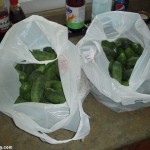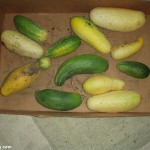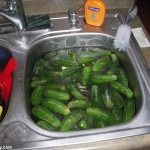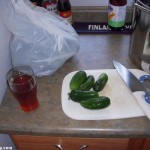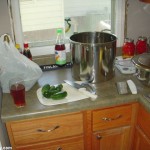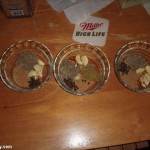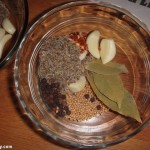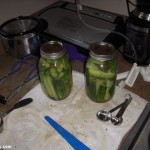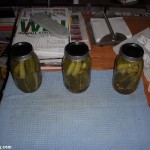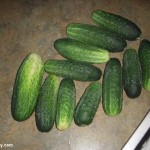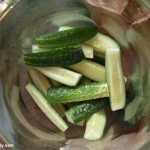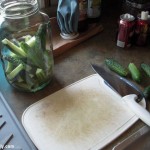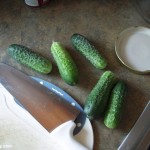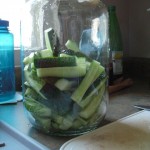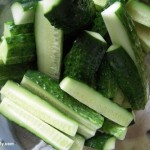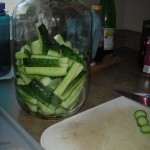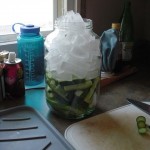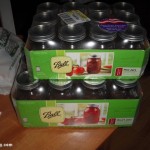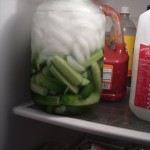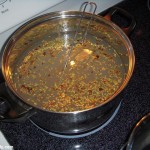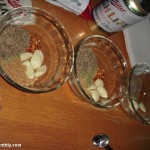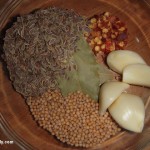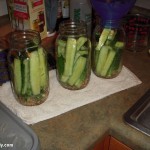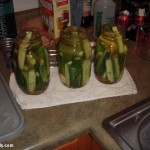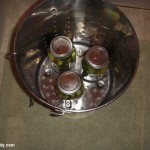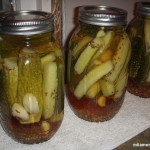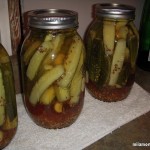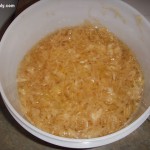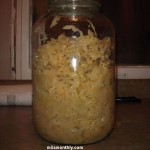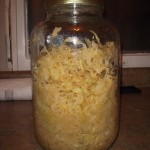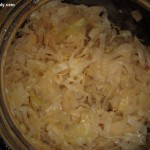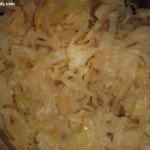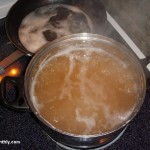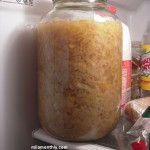You might remember these peppers from last year, when I received a random bag of them from my farmer neighbor, which I ended up canning into 2 pints of finished peppers. Well with the saved seeds from last year’s peppers, I was able to grow about 6 plants with varying degree of vigor. But after a roller coaster of a year, that included a freak hailstorm in early spring, as well as an early frost in the beginning of October. I thought that I wouldn’t take any more chances, and process all the ripen peppers before another frost rolled into town. Continue reading
Tag: canning salt
Dill Pickles – Brined – v4 – September 2010
At first I thought that I was going to process all the pickles that I bought at the downtown Farmer’s Market into v2 & v3 pickles. But while processing the ~7lbs of cucumbers for v2 & v3, I thought that I would go a different route and try to make some brine fermented pickles. Years and years ago back in Michigan I tried to make fermented pickles, and the experiment was an utter failure. So now that I’ve got a little bit more canning and homebrewing experience under my belt, I thought that I would give fermented pickles another try. Before this fermented experiment begun, I stopped by the library to pick up a copy of The Joy of Pickling by Linda Ziedrich(not the revised edition), to try and get a base recipe down, as well as some tips and tricks.
Continue reading
Dill Pickles – v2 & v3 – September 2010
Since the downtown farmer’s market isn’t going to be around for very much longer, I though that I should take advantage of the situation and make some more pickles before the season is over.
After doing a quick walk around to gauge the prices, I finally found a vendor that was selling 1 1/2 pint containers of pickling cucumbers for $2.00 each. Wanting to get the price even lower, I offer them $15 for 10 containers. We eventually settled on $18 for 10 containers (a $2 total discount). I have a feeling that if I had waited until noon (when the market stops) instead of when I was there at 11am, I could have gotten them for $15.
But I still got a hell of a good deal, since the two bags of cucumbers ended up weighing ~15 lbs, so at ~$1.20 lb it was still a great deal. Later on I didn’t realize how much ~15 lbs of cucumbers were until I started to process them. After getting through the first ~7 lb bag, I decided to make the pickles two different ways, fermented/brined and hot processed vinegar pickling (like v1.) Below you’ll see the recipes that I used for versions 2 and 3 of the vinegar pickles. The brined pickles (version 4) will be getting their own separate post.
Version 2.0
Brine:
(note: less vinegar & more water compared to v1)
- 3.5 cups vinegar
- 4.5 cups water
- 2 TB pickling spice mix
- 1/4 cup white sugar
- 1/2 cup canning salt
Bring Mixture to a boil, then simmer for 15 mins.
Per quart jar add:
(note: added black peppercorns & celery seeds compared to v1)
- 2 bay leaves
- 4 cloves garlic
- 1/4 tsp red pepper flakes
- 1/2 tsp whole black peppercorns
- 3/4 tsp celery seed
- 2 tsp mustard seed
- 3 tsp Dill seed
Process 15 mins in a boiling water canner
Yield: 3 quart jars
Version 3.0
I had some remaining brine from v2, so I just strained it. I then added 1.5 cups vinegar, 2.5 cups water, 4 TB white sugar, 1/4 cup of salt. This addition was just a little bit short. So I topped off the jars with a mixture of 1/4 cup vinegar & 1/4 cup water.
Brine:
(note: less vinegar & more water, also removed the pickling spice compared to v1 & v2)
- 3 cups vinegar
- 5 cups water
- 1/4 cup white sugar
- 1/2 cup canning salt
Bring Mixture to a boil, then simmer for 15 mins.
Per quart jar add:
(note: increased the red pepper flakes to 1/2 tsp, and increased the celery seed to 1 tsp compared to v2)
- 2 bay leaves
- 4 cloves garlic
- 1/2 tsp red pepper flakes
- 1/2 tsp whole black peppercorns
- 1 tsp celery seed
- 2 tsp mustard seed
- 3 tsp Dill seed
Process 15 mins in a boiling water canner
Yield: 4 quart jars
Side Notes:
1) Add the celery seeds after removing all the air from the jar with the food saver attachment. If you don’t, you’ll end up with a lot of seeds inside the attachment, instead of inside the jar.
2) One of the v3 jars doesn’t have any garlic inside, since I used up the rest of the garlic for the other three jars in v3. This was a one time problem, since I then ended up purchasing a 3 lb jug of peeled garlic.
3) Don’t over fill the jars, since it looks like with v3, I had a bit of a boil over in the canner kettle. Since the water was a little bit green after processing.
Pickled Spicy Beans – v2 & v3 – September 2010
When I saw the Labor Day ad from my local grocery store, it had a sale item that I had to pick-up. And what food item got me so interested, that I had to get it? Why none other then Michigan grown green beans for $0.58 lb. Yes, you read that right $0.58 a pound. And having finally cracked open a jar of the wax beans, and enjoyed the results. I thought that I would give it another try, but with green beans, and also with a couple of recipe modifications. Here are the results: Continue reading
Canning Tomatoes – Fall 2010
This year I’ve eaten more then my fair share of fresh tomatoes from the garden. So instead of letting a lot of tomatoes rot on the vine. I thought that it would be a good time to can all the tomatoes that are currently ripe. So this year, instead of using only “roma” type tomatoes, I’m basically going to be using a blend of all the tomatoes in the garden. Since a few weeks back I used of blend of tomatoes (roma, cherry/grape, heirloom, big boy) to make a quick tomato sauce, and it turned out awesome. Continue reading
Dill Pickles – v1 – 07/14/2010
And now for the final canning recipe, even though I made these a couple of days before the carrots and beans. I kind of went in a totally different route, in that I didn’t soak the pickle spears in a brine before canning. Since I’ve noticed that all the brine pre-soak does, is make your final product extra salty. So somewhere online, I saw a bunch of tips on soaking the sliced cucumbers in an ice-bath to increase the final pickles “crispness”. But seeing how I only soaked them for an hour before processing, I really don’t know if it added much to the recipe, since most recipes were suggesting a 4 to 5 hour ice bath before processing.
So on to rest of the recipe:
Brine
- 1 qt (4 cups) vinegar
- 1 qt (4 cups) water
- 2 TB pickling mix
- 1/4 cup white sugar
- 1/2 cup canning salt
Bring Mixture to a boil, then simmer for 15 mins.
Per quart jar add:
- 2 bay leaves
- 4 cloves garlic
- 1/4 tsp red pepper flakes
- 2 tsp mustard seed
- 3 tsp Dill seed
Remember to make sure and use to plastic knife to get out the air bubbles. I also use the mason jar attachment for the food saver to get all the bubbles out.
Yield: 3 quart jars
Process 15 mins in a boiling water canner
Side Notes:
1) Since these pickles were the first canning experiment of the year, I forgot a bunch of steps that I would normally do. The big one being to get the air bubbles out the jar before processing. I was lucky that all the jars sealed after processing. But I guess this is what I get for the first canning session of the year.
2) The brine amount in the recipe ended up being the prefect amount for three quart jars, with no waste.
3) Since I forgot to grow fresh dill this year to add to the pickles, I went with dill seed instead.
Pickled Spicy Beans – v1 – July 2010
So onto canning recipe number two and the spicy pickled beans. My original thinking about making the spicy pickled beans, was as a garnish for my occasional bloody mary’s. Plus this is another way for me to clear out all the bean plants, so that I can get the plot ready for a second planting of beans in a few weeks. Continue reading
Sauerkraut is done!
After a little bit over two months, I’m pulling the plug on the fermentation phase of this sauerkraut and moving on to the consumption phase of this batch. There was only a couple of things that I did to the sauerkraut before placing it into the fridge.
1) Cleaned and sanitized a 1 gallon glass jar (it was from a batch of pickles I bought last year at Sam’s Club.)
2) I squeezed all the brine out of the sauerkraut, leaving the brine in the fermentation bucket.
3) With the remaining brine in the fermentation bucket. I racked the brine to a stock pot and brought it to a rolling boiling, and kept it boiling for 15 minutes before cooling it down to room temperature in an ice bath.
4) Once the brine was cooled, I poured it back over the sauerkraut in the jar, just until the sauerkraut was covered in brine.
Now its time for me to start making some Reuben sandwiches at home, so I can consume all this sauerkraut. Good thing I didn’t buy more cabbage before St. Patrick’s day when it was $0.09 a lb, to start a second batch of sauerkraut. Since then I really would have had sauerkraut up the wazoo!
Sauerkraut – v1 – 10 days later
Its been a little over a week, and the cabbage is finally starting to slowly look and taste like sauerkraut, though it still has quite a bit of the cabbage crunch. Another couple of weeks fermenting, and we should be in sauerkraut city.
Side Note:
- When my mom mentioned if I had collected a large stone to place on top of the cabbage in the fermentor, I really didn’t understand what she was getting at. Well a week later I now understand the point she was making. The glass salad plate that I had used to submerge the cabbage in the brine was woefully insufficient. After about three days, all the gas that the cabbage was generating caused quite a bit of volume expansion in the fermentor to the point that I would have to squeeze down on the cabbage daily to degas it. Next time around I’m going to wrap a 15lb or 20 lb weight lifting plate in plastic in order to keep the sauerkraut submerged.
Turning cabbage into sauerkraut – v1
This is one of those strange projects that I’ve wanted to try for a very long time. Somehow an email chain was started in my clique, about one of them being on a cabbage fix lately. Since that chain email planted the cabbage seed in my head. When I ended up going to the grocery store this past weekend, they just happen to have cabbage for $0.33 a lb. Three heads of cabbage and 10 lbs later I was off and running with this sauerkraut experiment. Continue reading
